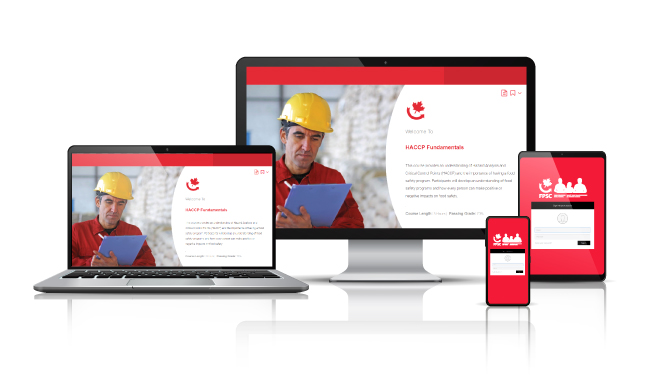HACCP Fundamentals
TIME
3 Hours
Pause and resume course as required
ANIMATED
All Modules
Each module has been specially audio and video animated for your learning and comprehension
CERTIFICATION
E-Certificate
Nationally recognized
COST
$199
LIMITED TIME OFFER
HACCP Fundamentals
This course will provide understanding of the importance of having food safety program and how every person working there can have either a positive or a negative impact on a food safety.
- You will learn that food safety hazards are biological, chemical, or physical substances that could make a food product unsafe to eat and cause illness, injury or death of a person.
- You will also hear how biological, chemical and physical hazards can be harmful to human health and how to prevent and control them.
- You will also hear why the Prerequisite programs and HACCP Plan are important part of the HACCP System.

Participants that have completed the course, will understand and be prepared to put into practice on the job the following:
- What the HACCP system is;
- The benefits of the HACCP system;
- Types of hazards and how to control them;
- GMP and Prerequisite Programs;
- HACCP plan development and implementation;
- HACCP system maintenance and review;
- Reasons a HACCP may fail and the most common non-conformities related to HACCP;

Student Support
24/7 Access to Training & Support

Virtual Instructor
Voice Narrated Content

Cost Effective
Affordable for everyone

User Friendly
Easy to use.
Who should take this course?
This course provides guideline for Line Workers in any type of food processing facility.
- New Hires
- Line Workers
- Supervisory and Management
- Quality Assurance Teams
Topics Covered
HACCP Fundamentals gives your staff everything they need to know to support, maintain and improve your jobsite food safety culture.
This includes 5 robust modules covering Food Safety Programs, Food Safety Hazards, Hazard Sources, Controlling Hazard Sources, and the Elements of a professional HACCP Plan.
- What is HACCP and Who Invented It
- What is Needed For a Successful HACCP System
- Management Commitment
- Importance of Line Workers
- Benefits of the HACCP System
- Types of Hazards
- Sources of Hazards
- People/Uniforms
- Equipment/Utensils/Tools
- Equipment/Utensils/Tools
- Incoming Material
- Cleaning
- Outside of Building as Source of Hazards
- Building as a Source of Hazard
- Pest Source of Hazards
- Water as Source of Hazards
- Types of Biological Hazards
- Growth Requirements for Microorganisms
- Chemical Hazards
- Canadian and USA Allergen List
- Physical Hazards
- Proper Handwashing Technique
- How Biological Hazards are Controlled
- How Chemical Hazards are Controlled
- How Physical Hazards are Controlled
- How Chemical Hazards are Controlled
- Cross-contamination
- Potential Food Safety Concerns4.7 Prerequisite Programs
- Step 1: Finished Product (Product Description)
- Step 2: Incoming Materials
- Step 3: Process Flow
- Step 4: Plant Schematic
- Step 5: Hazard Analysis and Control of Hazards Control Point
- Step 6: Process Controls (PC)
- Step 7: Critical Control Point
- Critical Control Points Examples
- Critical Limits
- Monitoring
- Monitoring Activities
- Verification of Monitoring Records
- Training of Employees
- Verification of Training
- Step 8: HACCP System Review
- Review of your HACCP System
- Update of your HACCP System when you have changes…
- Reasons why HACCP may fail
- Indicators of a Successful HACCP System
- Employee Guide to GMPs
- HACCP Process Flow
- Meat Cooking Record CCP
- Sample Receiving Record
- SOP Receiving Ingredients
For more information, contact:
Dayna Poulin, Manager of Training Development & Communications
Dayna Poulin, Manager of Training Development & Communications
Email: dpoulin@fpsc-ctac.com
Phone: 613-237-7988 x 226


